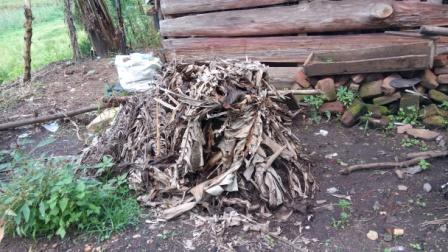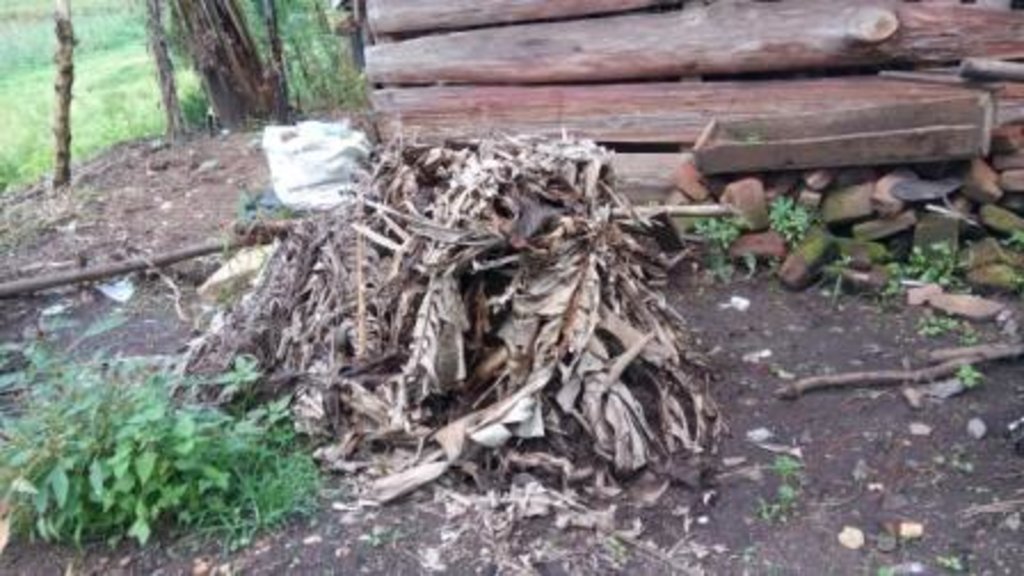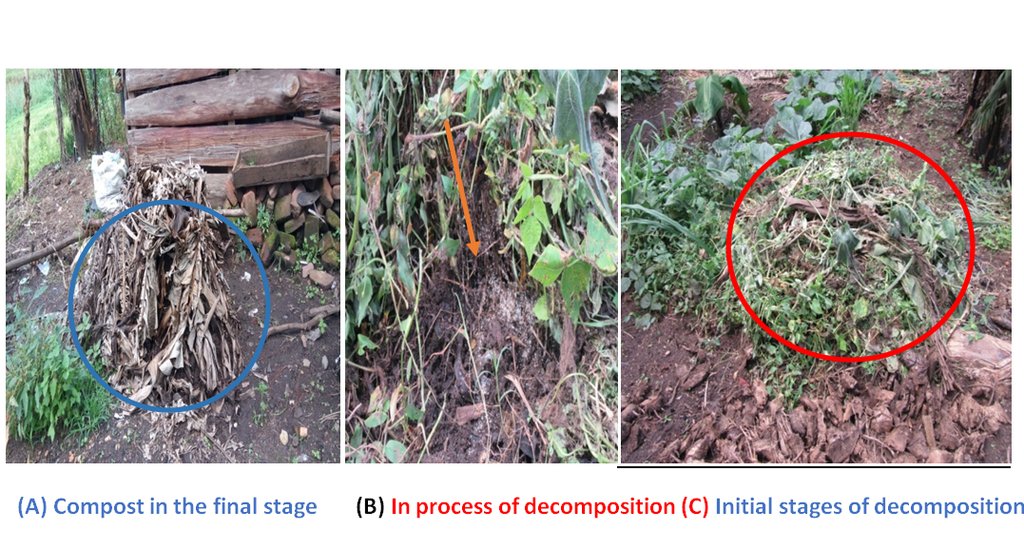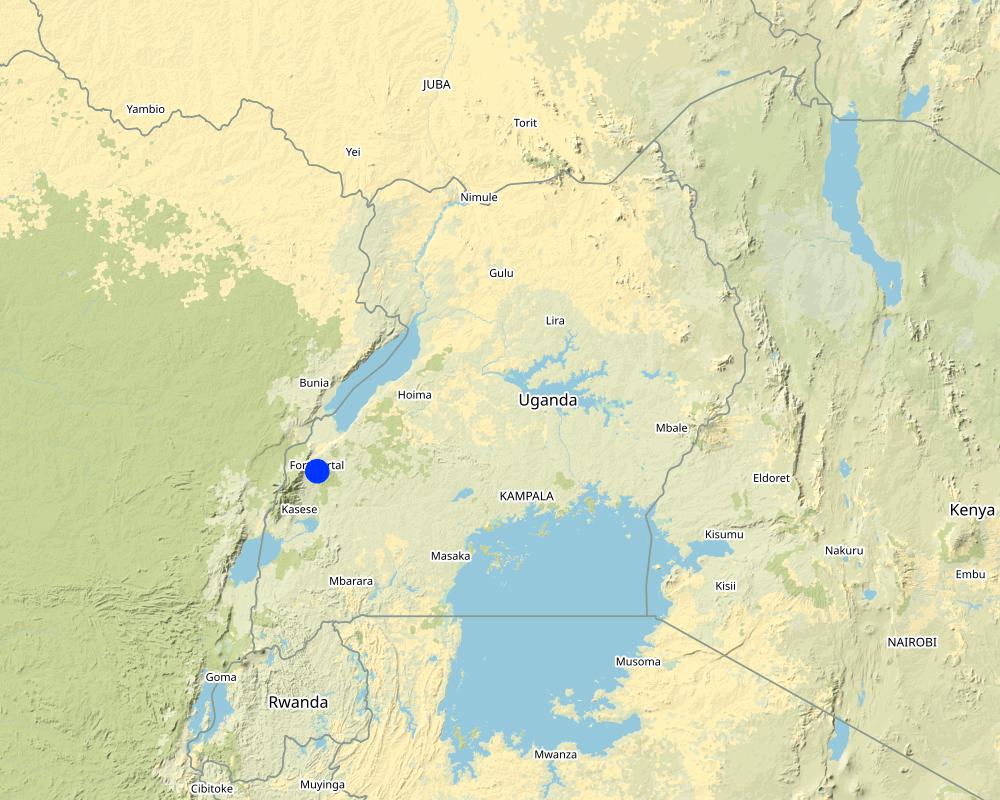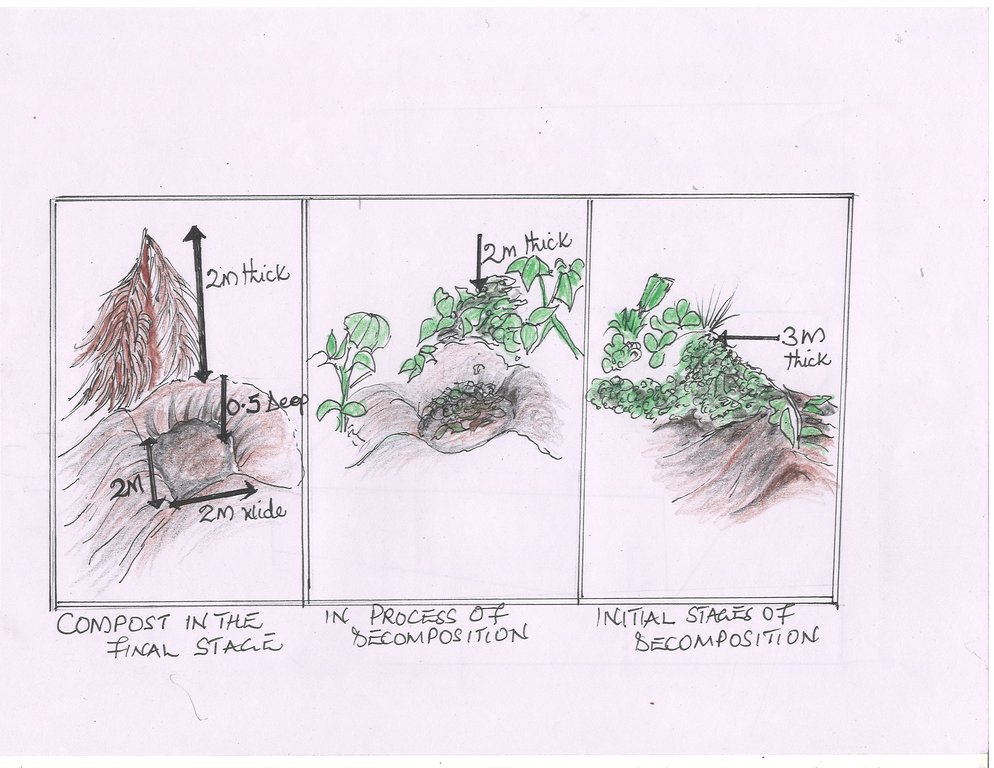Compost Production Pits for Crop Production [Uganda] [ยูกันดา]
- ผู้สร้างสรรค์:
- การอัพเดท:
- ผู้รวบรวม: Sarah Babirye
- ผู้เรียบเรียง: Kamugisha Rick Nelson
- ผู้ตรวจสอบ: Nicole Harari, Udo Höggel, Donia Mühlematter
Olwezo lwakasasilo
technologies_3303 - ยูกันดา
ดูส่วนย่อย
ขยายทั้งหมด ย่อทั้งหมด1. ข้อมูลทั่วไป
1.2 รายละเอียดที่ติดต่อได้ของผู้รวบรวมและองค์กรที่เกี่ยวข้องในการประเมินและการจัดเตรียมทำเอกสารของเทคโนโลยี
วิทยากรหลัก
ผู้ใช้ที่ดิน:
Baguma Innocent
0706385387
None
ยูกันดา
ชื่อของโครงการซึ่งอำนวยความสะดวกในการทำเอกสารหรือการประเมินเทคโนโลยี (ถ้าเกี่ยวข้อง)
Scaling-up SLM practices by smallholder farmers (IFAD)ชื่อขององค์กรซึ่งอำนวยความสะดวกในการทำเอกสารหรือการประเมินเทคโนโลยี (ถ้าเกี่ยวข้อง)
National Agricultural Research Organisation (NARO) - ยูกันดา1.3 เงื่อนไขการใช้ข้อมูลที่ได้บันทึกผ่านทาง WOCAT
วันที่เก็บรวบรวมข้อมูล(ภาคสนาม) :
17/10/2017
ผู้รวบรวมและวิทยากรหลักยอมรับเงื่อนไขเกี่ยวกับการใช้ข้อมูลที่ถูกบันทึกผ่านทาง WOCAT:
ใช่
1.4 การเปิดเผยเรื่องความยั่งยืนของเทคโนโลยีที่ได้อธิบายไว้
เทคโนโลยีที่ได้อธิบายไว้นี้เป็นปัญหาของความเสื่อมโทรมโทรมของที่ดินหรือไม่ จึงไม่ได้รับการยอมรับว่าเป็นเทคโนโลยีเพื่อการจัดการที่ดินอย่างยั่งยืน:
ไม่ใช่
แสดงความคิดเห็น:
It is a good sustainable land management technology that enables farmers locally to make cheap organic manure to increase food production while improving the degraded areas.
2. การอธิบายลักษณะของเทคโนโลยี SLM
2.1 การอธิบายแบบสั้น ๆ ของเทคโนโลยี
คำจำกัดความของเทคโนโลยี:
Compost manure production is a sustainable land management practice promoted by small scale farmers by using banana, cassava, sweet potato peelings, jack fruit residues and food left overs. The aim is to improve soil fertility, increase agricultural production and household income. The technology makes nutrients more readily available to plants in a short period of time through composting. During composting, raw organic matter is transformed into stable humus which is absorbed by plants thus enabling increased production.
2.2 การอธิบายแบบละเอียดของเทคโนโลยี
คำอธิบาย:
Compost manure application is an integrated pest, disease and soil fertility management technology that cheaply avails organic matter to increase crop/land productivity among local farmers. Farmers use locally available inputs like weeds, kitchen refuse, crop residues (maize, sorghum, millet, wheat among others) at less or no cost. These nutrients are thus made available to plants through transforming raw organic matter into stable humus, which is readily absorbed by plants. This increases agricultural and vegetable production. However, the nitrogen content in the compost can be further increased if waste plant materials such as Lantana Camara, Sesbania are integrated. Procedures to make compost manure include the following steps:
• Digging pits of about 2m length, 2 m width and 0.75 m depth.
• Placing the assorted organic materials in pit no. 1 and covering it with soil in a dome shape to prevent water from seeping into the decomposing materials. Residues so assembled should be in their raw form collected from either the kitchen, weeds from gardens, peelings and crop residues like maize and sugarcane husks. As a rule of thumb, the compost pile should be build by beginning with a bottom layer of bigger sized materials, such as maize stovers, of about 15cm height. This should also include a layer of dry vegetation, hedge or grass cuttings to about 15cm height. Sprinkling top soil and adding water by using a watering can will to moisten the whole layer. In this pit, the degradation process will take a period of 1-2 months.
• In the third month, the materials are then transferred to pit no. 2, arranged and compressed in layers and covered with soil in a dome shaped manner.
• After another spell of 4-5 months, these decomposed materials are then transferred to pit no. 3. This comprises of decomposed matter ready for use. In this last pit, manure in the final stage is always cold, dark and most importantly, less bulky. It produces a pleasant smell when spread.
In case of a banana plantation, ready compost is applied around the banana hills or in trenches between 4 banana plants. Soils with compost cannot easily be washed away by water or blown by wind as the soil particles are held tightly together with the sticky substance secreted in the process of decomposition. This glue-like structure also helps to hold moisture in the soil hence improving the structure.
The farmer selects a suitable and convenient place for the compost pit system preferably near the garden and home stead where he digs three pits. The cost of digging a compost pit depends on where the pits are to be located. If the place is easy to dig, each pit costs about UGX 5,000/=. Other costs include, hiring a spade at UGX 1,000/=, a hoe at UGX 1,000/=, a pan at UGX 1,000/= and a watering can at UGX 1,000/=, all summing up to UGX 9000/= for the whole activity. The technology improves production in both annual and perennial plants such as fodder grasses and crops through restoring degraded soils by improving soil structure, soil moisture and micro organism content. As the technology provides nutrients to plants it also reduces environmental pollution associated with inorganic fertilizer use. Nutrients are released gradually, enabling the following year’s crops to benefit as well. Weeding is done easily in areas applied with compost manure as the soil has a soft texture. Through this technology, home hygiene is improved by utilising wastes. Plant diseases and pests like banana weevils are suppressed.
However, making compost manure is challenging. It requires a lot of commitment and serious efforts to collect the kitchen and garden residues all the time. Digging a pit is quite laborious and farmers with little land find it hard to reserve land for compost pits.
This technology is an agronomic measure that helps in waste management through recycling, re-use or reduction of wastes, thereby improving sustainable land management. Maintenance is always by ensuring that compost pits are not under permanent shade and properly covered. Pits should be emptied after the process is done in preparation for the next cycle.
2.3 รูปภาพของเทคโนโลยี
2.4 วีดีโอของเทคโนโลยี
วันที่:
17/10/2017
สถานที่:
FORTPORTAL, KABAROLE DIST
ชื่อผู้ถ่ายวีดีโอ:
Aine Amon
2.5 ประเทศภูมิภาค หรือสถานที่ตั้งที่เทคโนโลยีได้นำไปใช้และได้รับการครอบคลุมโดยการประเมินนี้
ประเทศ:
ยูกันดา
ภูมิภาค/รัฐ/จังหวัด:
KABAROLE
ข้อมูลจำเพาะเพิ่มเติมของสถานที่ตั้ง :
FORTPORTAL MUNICIPALITY
แสดงความคิดเห็น:
Coordinate points where the technology was captured were E 03017319 (Longitude) and Latitude N 004014.4
Map
×2.6 วันที่การดำเนินการ
ถ้าไม่รู้ปีที่แน่นอน ให้ระบุวันที่โดยประมาณ:
- น้อยกว่า 10 ปี (ไม่นานนี้)
2.7 คำแนะนำของเทคโนโลยี
ให้ระบุว่าเทคโนโลยีถูกแนะนำเข้ามาอย่างไร:
- ในช่วงการทดลองหรือการทำวิจัย
3. การจัดประเภทของเทคโนโลยี SLM
3.1 วัตถุประสงค์หลักของเทคโนโลยี
- ปรับปรุงการผลิตให้ดีขึ้น
- ลด ป้องกัน ฟื้นฟู การเสื่อมโทรมของที่ดิน
3.2 ประเภทของการใช้ที่ดินในปัจจุบันที่ได้นำเทคโนโลยีไปใช้

พื้นที่ปลูกพืช
- การปลูกพืชล้มลุกอายุปีเดียว
- การปลูกพืชยืนต้นที่ไม่มีเนื้อไม้
พืชหลัก (พืชเศรษฐกิจและพืชอาหาร):
Bananas, vegetables (cabbage, amarathus among others)
ถ้าการใช้ที่ดินมีการเปลี่ยนแปลงเนื่องมาจากการนำเทคโนโลยีไปปฏิบัติใช้ ให้ระบุการใช้ที่ดินก่อนนำเทคโนโลยีไปปฏิบัติใช้:
Land use has not changed due to the technology applied.
3.3 ข้อมูลเพิ่มเติมเกี่ยวกับการใช้ที่ดิน
การใช้น้ำของที่ดินที่มีการใช้เทคโนโลยีอยู่:
- จากน้ำฝน
จำนวนของฤดูเพาะปลูกต่อปี:
- 2
3.4 กลุ่ม SLM ที่ตรงกับเทคโนโลยีนี้
- การจัดการความอุดมสมบรูณ์ของดินแบบผสมผสาน
- สวนครัว
3.5 กระจายตัวของเทคโนโลยี
ระบุการกระจายตัวของเทคโนโลยี:
- ใช้ ณ จุดที่เฉพาะเจาะจงหรือเน้นไปยังบริเวณพื้นที่ขนาดเล็ก
แสดงความคิดเห็น:
In case of banana plantation, the compost is applied around banana heaps and in trenches between 4 banana heap.
3.6 มาตรการ SLM ที่ประกอบกันเป็นเทคโนโลยี

มาตรการจัดการพืช
- A2: อินทรียวัตถุในดิน/ความอุดมสมบูรณ์ในดิน

มาตรการอนุรักษ์ด้วยโครงสร้าง
- S4: คูน้ำแนวระดับ หลุม

มาตรการอนุรักษ์ด้วยการจัดการ
- M6: การจัดการของเสีย (การทำ รีไซเคิล การเอากลับมาใช้ใหม่หรือการลดปริมาณ)
3.7 รูปแบบหลักของการเสื่อมโทรมของที่ดินที่ได้รับการแก้ไขโดยเทคโนโลยี

การกัดกร่อนของดินโดยน้ำ

การเสื่อมโทรมของดินทางด้านเคมี
- Cn (Fertility decline): ความอุดมสมบูรณ์และปริมาณอินทรียวัตถุในดินถูกทำให้ลดลงไป (ไม่ได้เกิดจากสาเหตุการกัดกร่อน)

การเสื่อมโทรมของดินทางด้านชีวภาพ
- Bc (Reduction of vegetation cover): การลดลงของจำนวนพืชที่ปกคลุมดิน
- Bq (Quantity/biomass decline): การลดลงของปริมาณหรือมวลชีวภาพ
- Bl (Loss of soil life): การสูญเสียสิ่งมีชีวิตในดิน
3.8 การป้องกัน การลดลง หรือการฟื้นฟูความเสื่อมโทรมของที่ดิน
ระบุเป้าหมายของเทคโนโลยีกับความเสื่อมโทรมของที่ดิน:
- ลดความเสื่อมโทรมของดิน
- ฟื้นฟูบำบัดที่ดินที่เสื่อมโทรมลงอย่างมาก
แสดงความคิดเห็น:
Compost manure application reduces /restores degraded soils. This is throug improving soil structure, soil moisture and micro organism content.
4. ข้อมูลจำเพาะด้านเทคนิค กิจกรรมการนำไปปฏิบัติใช้ ปัจจัยนำเข้า และค่าใช้จ่าย
4.1 แบบแปลนทางเทคนิคของเทคโนโลยี
4.2 ข้อมูลจำเพาะด้านเทคนิคและการอธิบายแบบแปลนทางเทคนิค
The dimensions for the compost pits are:
Width 2 m
Length 2 m
Depth 0.5 m
Slope: Gentle slope
4.3 ข้อมูลทั่วไปเกี่ยวกับการคำนวณปัจจัยนำเข้าและค่าใช้จ่าย
ให้ระบุว่าค่าใช้จ่ายและปัจจัยนำเข้าได้รับการคำนวณอย่างไร:
- ต่อหน่วยเทคโนโลยี
อื่นๆ หรือสกุลเงินประจำชาติ (ระบุ):
UGX
ระบุอัตราแลกเปลี่ยนจากดอลลาร์สหรัฐเป็นสกุลเงินท้องถิ่น (ถ้าเกี่ยวข้อง) คือ 1 เหรียญสหรัฐ =:
3224.0
ระบุค่าเฉลี่ยของค่าจ้างในการจ้างแรงงานต่อวัน:
1 Pit costs 2500/= (i.e Labour to construct a pit where the residues are deposited).
4.4 กิจกรรมเพื่อการจัดตั้ง
| กิจกรรม | ประเภทของมาตรการ | ช่วงเวลาดำเนินการ | |
|---|---|---|---|
| 1. | Select a suitable place near the garden and near the home stead | มาตรการอื่น ๆ | Once |
| 2. | Site should not be under permanent shade | มาตรการอื่น ๆ | Once |
| 3. | Put top soil in between different layers to quicken decomposition | ด้วยโครงสร้าง | once |
| 4. | After filling with materials,cover with soil and make it dome shaped | ด้วยโครงสร้าง | Once |
| 5. | leave it to settle for 4-5 months when it is fully decomposed | มาตรการอื่น ๆ | Once |
4.5 ค่าใช้จ่ายของปัจจัยนำเข้าที่จำเป็นสำหรับการจัดตั้ง
| ปัจจัยนำเข้า | หน่วย | ปริมาณ | ค่าใช้จ่ายต่อหน่วย | ค่าใช้จ่ายทั้งหมดต่อปัจจัยนำเข้า | %ของค่าใช้จ่ายที่ก่อให้เกิดขึ้นโดยผู้ใช้ที่ดิน | |
|---|---|---|---|---|---|---|
| แรงงาน | Digging 3 Pits | man pit | 3.0 | 2500.0 | 7500.0 | 100.0 |
| อุปกรณ์ | Hiring a hoe | pic | 1.0 | 1000.0 | 1000.0 | 100.0 |
| อุปกรณ์ | Hiring a spade | pic | 1.0 | 1000.0 | 1000.0 | 100.0 |
| อุปกรณ์ | Hiring a watering can | pic | 1.0 | 1000.0 | 1000.0 | 100.0 |
| อุปกรณ์ | Hiring a pan | pic | 1.0 | 1000.0 | 1000.0 | 100.0 |
| ค่าใช้จ่ายทั้งหมดของการจัดตั้งเทคโนโลยี | 11500.0 | |||||
ถ้าผู้ใช้ที่ดินรับภาระน้อยกว่า 100% ของค่าใช้จ่าย ให้ระบุว่าใครเป็นผู้รับผิดชอบส่วนที่เหลือ:
All costs are covered by the land user (100%)
แสดงความคิดเห็น:
The technology is cost efficient to low income farmers.
4.6 การบำรุงรักษาสภาพหรือกิจกรรมที่เกิดขึ้นเป็นประจำ
| กิจกรรม | ประเภทของมาตรการ | ช่วงระยะเวลา/ความถี่ | |
|---|---|---|---|
| 1. | By covering the manure under decomposition | ด้วยการจัดการ | Every 5 months |
| 2. | By empying the pits when manure is ready | ด้วยการจัดการ | Every 5 months |
แสดงความคิดเห็น:
The technology has few activities on the maintenance side.
4.7 ค่าใช้จ่ายของปัจจัยนำเข้าและกิจกรรมที่เกิดขึ้นเป็นประจำที่ต้องการการบำรุงรักษา (ต่อปี)
| ปัจจัยนำเข้า | หน่วย | ปริมาณ | ค่าใช้จ่ายต่อหน่วย | ค่าใช้จ่ายทั้งหมดต่อปัจจัยนำเข้า | %ของค่าใช้จ่ายที่ก่อให้เกิดขึ้นโดยผู้ใช้ที่ดิน | |
|---|---|---|---|---|---|---|
| แรงงาน | Emptying pits | 1.0 | 2500.0 | 2500.0 | 100.0 | |
| อุปกรณ์ | Hiring a hoe | pic | 1.0 | 1000.0 | 1000.0 | 100.0 |
| อุปกรณ์ | Hiring a spade | pic | 1.0 | 1000.0 | 1000.0 | 100.0 |
| อุปกรณ์ | Hiring a pan | pic | 1.0 | 1000.0 | 1000.0 | 100.0 |
| ค่าใช้จ่ายทั้งหมดของการบำรุงรักษาสภาพเทคโนโลยี | 5500.0 | |||||
4.8 ปัจจัยสำคัญที่สุดที่มีผลกระทบต่อค่าใช้จ่าย
ปัจจัยสำคัญที่สุดที่มีผลกระทบต่อค่าใช้จ่ายต่างๆ:
Labour. Despite the fact that the technology is highly cost effective, most farmers lack money to hire people to dig pits for them and buy the few necessary inputs like spade, hoes for the activity to take place.
5. สิ่งแวดล้อมทางธรรมชาติและของมนุษย์
5.1 ภูมิอากาศ
ฝนประจำปี
- < 250 ม.ม.
- 251-500 ม.ม.
- 501-750 ม.ม.
- 751-1,000 ม.ม.
- 1,001-1,500 ม.ม.
- 1,501-2,000 ม.ม.
- 2,001-3,000 ม.ม.
- 3,001-4,000 ม.ม.
- > 4,000 ม.ม.
เขตภูมิอากาศเกษตร
- ชื้น
5.2 สภาพภูมิประเทศ
ค่าเฉลี่ยความลาดชัน:
- ราบเรียบ (0-2%)
- ลาดที่ไม่ชัน (3-5%)
- ปานกลาง (6-10%)
- เป็นลูกคลื่น (11-15%)
- เป็นเนิน (16-30%)
- ชัน (31-60%)
- ชันมาก (>60%)
ธรณีสัณฐาน:
- ที่ราบสูง/ที่ราบ
- สันเขา
- ไหล่เขา
- ไหล่เนินเขา
- ตีนเนิน
- หุบเขา
ระดับความสูง:
- 0-100 เมตร
- 101-500 เมตร
- 501-1,000 เมตร
- 1,001-1,500 เมตร
- 1,501-2,000 เมตร
- 2,001-2,500 เมตร
- 2,501-3,000 เมตร
- 3,001-4,000 เมตร
- > 4,000 เมตร
ให้ระบุถ้าเทคโนโลยีได้ถูกนำไปใช้:
- ไม่เกี่ยวข้อง
5.3 ดิน
ค่าเฉลี่ยความลึกของดิน:
- ตื้นมาก (0-20 ซ.ม.)
- ตื้น (21-50 ซ.ม.)
- ลึกปานกลาง (51-80 ซ.ม.)
- ลึก (81-120 ซ.ม.)
- ลึกมาก (>120 ซ.ม.)
เนื้อดิน (ดินชั้นบน):
- ปานกลาง (ดินร่วน ทรายแป้ง)
เนื้อดินล่าง (> 20 ซ.ม.ต่ำจากผิวดิน):
- ปานกลาง (ดินร่วน ทรายแป้ง)
อินทรียวัตถุในดิน:
- ปานกลาง (1-3%)
5.4 ความเป็นประโยชน์และคุณภาพของน้ำ
ระดับน้ำใต้ดิน:
5-50 เมตร
น้ำไหลบ่าที่ผิวดิน:
ปานกลาง
คุณภาพน้ำ (ที่ยังไม่ได้บำบัด):
เป็นน้ำใช้เพื่อการเกษตรเท่านั้น (การชลประทาน)
ความเค็มของน้ำเป็นปัญหาหรือไม่:
ไม่ใช่
กำลังเกิดน้ำท่วมในพื้นที่หรือไม่:
ไม่ใช่
5.5 ความหลากหลายทางชีวภาพ
ความหลากหลายทางชนิดพันธุ์:
- ปานกลาง
ความหลากหลายของแหล่งที่อยู่:
- ปานกลาง
5.6 ลักษณะของผู้ใช้ที่ดินที่นำเทคโนโลยีไปปฏิบัติใช้
อยู่กับที่หรือเร่ร่อน:
- อยู่กับที่
แนวทางการตลาดของระบบการผลิต:
- เพื่อการยังชีพ (หาเลี้ยงตนเอง)
รายได้ที่มาจากนอกฟาร์ม:
- > 50% ของรายได้ทั้งหมด
ระดับของความมั่งคั่งโดยเปรียบเทียบ:
- พอมีพอกิน
เป็นรายบุคคล/ครัวเรือน:
- เป็นรายบุคคล/ครัวเรือน
ระดับของการใช้เครื่องจักรกล:
- งานที่ใช้แรงกาย
เพศ:
- หญิง
อายุของผู้ใช้ที่ดิน:
- วัยกลางคน
5.7 พื้นที่เฉลี่ยของที่ดินที่เป็นเจ้าของหรือเช่าโดยผู้ใช้ที่ดินที่นำเทคโนโลยีไปปฏิบัติใช้
- < 0.5 เฮกตาร์
- 0.5-1 เฮกตาร์
- 1-2 เฮกตาร์
- 2-5 เฮกตาร์
- 5-15 เฮกตาร์
- 15-50 เฮกตาร์
- 50-100 เฮกตาร์
- 100-500 เฮกตาร์
- 500-1,000 เฮกตาร์
- 1,000-10,000 เฮกตาร์
- >10,000 เฮกตาร์
พิจารณาว่าเป็นขนาดเล็ก กลาง หรือขนาดใหญ่ (ซึ่งอ้างอิงถึงบริบทระดับท้องถิ่น):
- ขนาดเล็ก
5.8 กรรมสิทธิ์ในที่ดิน สิทธิในการใช้ที่ดินและสิทธิในการใช้น้ำ
กรรมสิทธิ์ในที่ดิน:
- รายบุคคล ไม่ได้รับสิทธิครอบครอง
สิทธิในการใช้ที่ดิน:
- รายบุคคล
สิทธิในการใช้น้ำ:
- เกี่ยวกับชุมชน (ถูกจัดระเบียบ)
5.9 การเข้าถึงบริการและโครงสร้างพื้นฐาน
สุขภาพ:
- จน
- ปานกลาง
- ดี
การศึกษา:
- จน
- ปานกลาง
- ดี
ความช่วยเหลือทางด้านเทคนิค:
- จน
- ปานกลาง
- ดี
การจ้างงาน (เช่น ภายนอกฟาร์ม):
- จน
- ปานกลาง
- ดี
ตลาด:
- จน
- ปานกลาง
- ดี
พลังงาน:
- จน
- ปานกลาง
- ดี
ถนนและการขนส่ง:
- จน
- ปานกลาง
- ดี
น้ำดื่มและการสุขาภิบาล:
- จน
- ปานกลาง
- ดี
บริการด้านการเงิน:
- จน
- ปานกลาง
- ดี
6. ผลกระทบและสรุปคำบอกกล่าว
6.1 ผลกระทบในพื้นที่ดำเนินการ (On-site) จากการใช้เทคโนโลยี
ผลกระทบทางด้านเศรษฐกิจและสังคม
การผลิต
การผลิตพืชผล
จำนวนก่อน SLM:
8Kg of bananas in 1 acre
หลังจาก SLM:
25kg of banana in 1 acre
คุณภาพพืชผล
การผลิตพืชที่ใช้เลี้ยงปศุสัตว์
คุณภาพพืชที่ใช้เลี้ยงปศุสัตว์
รายได้และค่าใช้จ่าย
รายได้จากฟาร์ม
แสดงความคิดเห็น/ระบุ:
Farmers are able with the use of this technology to harvest high yields for both home consumption and commercial purposes.
ผลกระทบด้านสังคมวัฒนธรรมอื่น ๆ
ความมั่นคงด้านอาหาร / พึ่งตนเองได้
ผลกระทบด้านนิเวศวิทยา
ดิน
ความชื้นในดิน
แสดงความคิดเห็น/ระบุ:
Moisture increases to 75%
การสูญเสียดิน
แสดงความคิดเห็น/ระบุ:
Soils with composts cannot easily be blown by water and wind as the soil particles are held tightly together with the sticky substance secreted in the process. This glue-like structure also helps to hold moisture in the soil hence improving the soil texture and structure and therefore wind and rains cannot blow away the soils.
การหมุนเวียนและการเติมของธาตุอาหาร
แสดงความคิดเห็น/ระบุ:
Nutrients can be recycled in the soil over and over again in the process of applying this manure to the soil.
อินทรียวัตถุในดิน/ต่ำกว่าดินชั้น C
แสดงความคิดเห็น/ระบุ:
Breaking down of matter like weeds, shrubs, kitchen residues (banana, cassava, sweet potato peelings) into humus by the micro-organisms improve on the soil organic matter.
ความหลากหลายทางชีวภาพของพืชและสัตว์
การปกคลุมด้วยพืช
แสดงความคิดเห็น/ระบุ:
High fertility levels of the soils from theses decomposed composts increase the vegetation cover as a result of humus generated.
ความหลากหลายทางชีวภาพของสัตว์
แสดงความคิดเห็น/ระบุ:
The quantity of annelids like earth worms increased. This is because they feed on both live and dead organic matter. Earthworms help in the breaking down of organic matter into humus and improve on soil aeration.
การจัดการศัตรูพืชและโรคพืช
แสดงความคิดเห็น/ระบุ:
Besides enriching the soil with fertility, the compost manure has the ability to suppress diseases and pests in the garden like the banana weevil.
6.2 ผลกระทบนอกพื้นที่ดำเนินการ (Off-site) จากการใช้เทคโนโลยี
ความคิดเห็นเกี่ยวกับการประเมินผลกระทบ:
The technology has no off site impacts.
6.4 การวิเคราะห์ค่าใช้จ่ายและผลประโยชน์ที่ได้รับ
ผลประโยชน์ที่ได้รับเปรียบเทียบกับค่าใช้จ่ายในการจัดตั้งเป็นอย่างไร (จากมุมมองของผู้ใช้ที่ดิน)
ผลตอบแทนระยะสั้น:
ด้านบวกอย่างมาก
ผลตอบแทนระยะยาว:
ด้านบวกอย่างมาก
ผลประโยชน์ที่ได้รับเปรียบเทียบกับค่าใช้จ่ายในการบำรุงรักษาหรือต้นทุนที่เกิดขึ้นซ้ำอีก เป็นอย่างไร (จากมุมมองของผู้ใช้ที่ดิน)
ผลตอบแทนระยะสั้น:
ด้านบวกอย่างมาก
ผลตอบแทนระยะยาว:
ด้านบวกอย่างมาก
6.5 การปรับตัวของเทคโนโลยี
- 1-10%
จากทั้งหมดที่ได้รับเทคโนโลยีเข้ามามีจำนวนเท่าใดที่ทำแบบทันที โดยไม่ได้รับการจูงใจด้านวัสดุหรือการเงินใด ๆ:
- 90-100%
6.6 การปรับตัว
เทคโนโลยีได้รับการปรับเปลี่ยนเมื่อเร็วๆนี้ เพื่อให้ปรับตัวเข้ากับสภาพที่กำลังเปลี่ยนแปลงหรือไม่:
ไม่ใช่
6.7 จุดแข็ง / ข้อได้เปรียบ / โอกาสของเทคโนโลยี
| จุดแข็ง / ข้อได้เปรียบ / โอกาสในทัศนคติของผู้ใช้ที่ดิน |
|---|
|
Manure made on farm is cheaper than when it is brought from off farm. Organic manure improves on soil structure. |
|
Manure is readily available. Increases water holding capacity. |
| The technology improves on home hygiene. |
| จุดแข็ง / ข้อได้เปรียบ / โอกาสในทัศนคติของผู้รวบรวมหรือวิทยากรหลัก |
|---|
| It is a very cheap technology that avails manure to farmers using locally available materials. |
| Poor farmers who cannot afford buying in organic fertilizers can improve on their yields using this technology. |
6.8 จุดอ่อน / ข้อเสียเปรียบ / ความเสี่ยงของเทคโนโลยีและวิธีการแก้ไข
| จุดอ่อน / ข้อเสียเปรียบ / ความเสี่ยงในทัศนคติของผู้ใช้ที่ดิน | มีวิธีการแก้ไขได้อย่างไร |
|---|---|
| The technology requires a garden that is so close to the homestead since the materials are bulky to carry. | Make pits closer to the home. |
| Need to control the rainfall run off from the decomposing area. | Advisable to construct pits under shades. |
| Microbes required to release nutrients require moisture so seasonal variations may affect the system. | Farmers should always utilize the seasons' conditions to enable best microbial action. |
| จุดอ่อน / ข้อเสียเปรียบ / ความเสี่ยงในทัศนคติของผู้รวบรวมหรือวิทยากรหลัก | มีวิธีการแก้ไขได้อย่างไร |
|---|---|
| Few farmers have adopted the technology since it demands commitment. | Sensitization to farmers on the importance of organic manure. |
| There is always a bad smell before the materials are covered up hence may result to conflicts from neighbours. | Collecting the wastes faster and cover them immediately. |
7. การอ้างอิงและการเชื่อมต่อ
7.1 วิธีการและแหล่งข้อมูล
- ไปเยี่ยมชมภาคสนาม การสำรวจพื้นที่ภาคสนาม
1
- การสัมภาษณ์กับผู้ใช้ที่ดิน
1
- การสัมภาษณ์ผู้เชี่ยวชาญด้าน SLM หรือผู้ชำนาญ
1
7.2 การอ้างอิงถึงสิ่งตีพิมพ์
หัวข้อ, ผู้เขียน, ปี, หมายเลข ISBN:
The Effects Of Various Organic Fertilizers On Growth Biology Essay,PASCHALIS BARLAS,2013
ชื่อเรื่อง ผู้เขียน ปี ISBN:
https://www.uniassignment.com/essay-samples/biology/the-effects-of-various-organic-fertilizers-on-growth-biology-essay.php
7.3 เชื่อมโยงกับข้อมูลที่มีอยู่บนออนไลน์
ชื่อเรื่องหรือคำอธิบาย:
Climate change mitigation potential of agricultural practices supported by IFAD investments by Mery Richards,Aslihan Arslan,Romina Cavatassi Todd Rosenstock
URL:
https://www.academia.edu/38512422/IFAD_RESEARCH_SERIES_35_-_Climate_change_mitigation_potential_of_agricultural_practices_supported_by_IFAD_investments_An_ex_ante_analysis
ลิงก์และโมดูล
ขยายทั้งหมด ย่อทั้งหมดลิงก์
ไม่มีลิงก์
โมดูล
ไม่มีโมดูล


